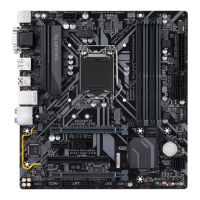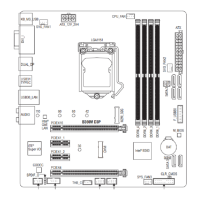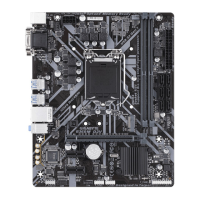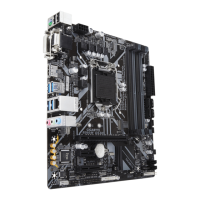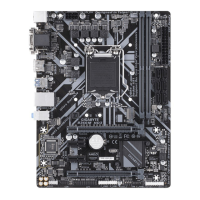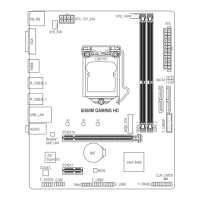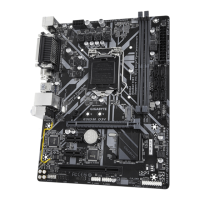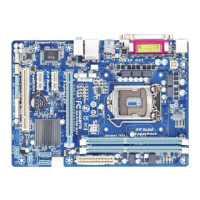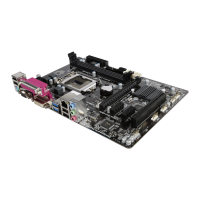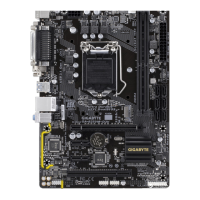Do you have a question about the Gigabyte B360M D3V and is the answer not in the manual?
Lists all items included in the motherboard packaging for user reference.
Safety guidelines for installing hardware to prevent damage.
Detailed technical specifications of the motherboard components and features.
Step-by-step guide for safely installing the CPU onto the motherboard socket.
Instructions on how to install RAM modules into the motherboard slots.
Guidance on inserting expansion cards into PCI Express slots.
Identification and description of external ports on the motherboard's back panel.
Overview of internal headers and connectors on the motherboard for system building.
Displays the initial GIGABYTE logo screen upon system boot.
Introduces the main BIOS interface, including classic and easy modes.
Advanced settings for CPU, memory, and voltage for overclocking and performance tuning.
Displays system information, language, date, and time settings.
Configuration options related to boot sequences, security, and system startup behavior.
Settings for onboard devices like LAN, audio, USB, and storage controllers.
Configuration options for onboard graphics, audio, and chipset features.
Power management settings, wake-up events, and AC power loss behavior.
Options for saving BIOS changes, loading defaults, or exiting the setup utility.
Step-by-step guide for installing and enabling Intel Optane memory.
Instructions on how to install essential motherboard drivers and software.
Lists all items included in the motherboard packaging for user reference.
Safety guidelines for installing hardware to prevent damage.
Detailed technical specifications of the motherboard components and features.
Step-by-step guide for safely installing the CPU onto the motherboard socket.
Instructions on how to install RAM modules into the motherboard slots.
Guidance on inserting expansion cards into PCI Express slots.
Identification and description of external ports on the motherboard's back panel.
Overview of internal headers and connectors on the motherboard for system building.
Displays the initial GIGABYTE logo screen upon system boot.
Introduces the main BIOS interface, including classic and easy modes.
Advanced settings for CPU, memory, and voltage for overclocking and performance tuning.
Displays system information, language, date, and time settings.
Configuration options related to boot sequences, security, and system startup behavior.
Settings for onboard devices like LAN, audio, USB, and storage controllers.
Configuration options for onboard graphics, audio, and chipset features.
Power management settings, wake-up events, and AC power loss behavior.
Options for saving BIOS changes, loading defaults, or exiting the setup utility.
Step-by-step guide for installing and enabling Intel Optane memory.
Instructions on how to install essential motherboard drivers and software.
| Non-ECC | Yes |
|---|---|
| Memory channels | Dual-channel |
| Memory slots type | DIMM |
| Number of memory slots | 2 |
| Supported memory types | DDR4-SDRAM |
| Maximum internal memory | 32 GB |
| Supported memory clock speeds | 2133, 2400, 2666 MHz |
| Supported memory module capacities | 16GB |
| Component for | PC |
| Power source type | ATX |
| Motherboard chipset | Intel® B360 |
| Audio output channels | 7.1 channels |
| Motherboard form factor | micro ATX |
| Motherboard chipset family | Intel |
| Windows operating systems supported | Windows 10 |
| Processor socket | LGA 1151 (Socket H4) |
| Compatible processor series | Intel Celeron, Intel Core i3, Intel Core i5, Intel Core i7, Intel Pentium |
| Ethernet interface type | Gigabit Ethernet |
| BIOS type | UEFI AMI |
| ACPI version | 5.0 |
| BIOS memory size | 16 Mbit |
| Supported storage drive types | HDD & SSD |
| PCI Express x16 slots | 1 |
| Number of SATA III connectors | 6 |
| USB 3.2 Gen 2 (3.1 Gen 2) connectors | 0 |
| USB 2.0 ports quantity | USB 2.0 ports have a data transmission speed of 480 Mbps, and are backwards compatible with USB 1.1 ports. You can connect all kinds of peripheral devices to them. |
| USB 3.2 Gen 1 (3.1 Gen 1) Type-A ports quantity | 4 |
| Depth | 185 mm |
|---|---|
| Width | 244 mm |
